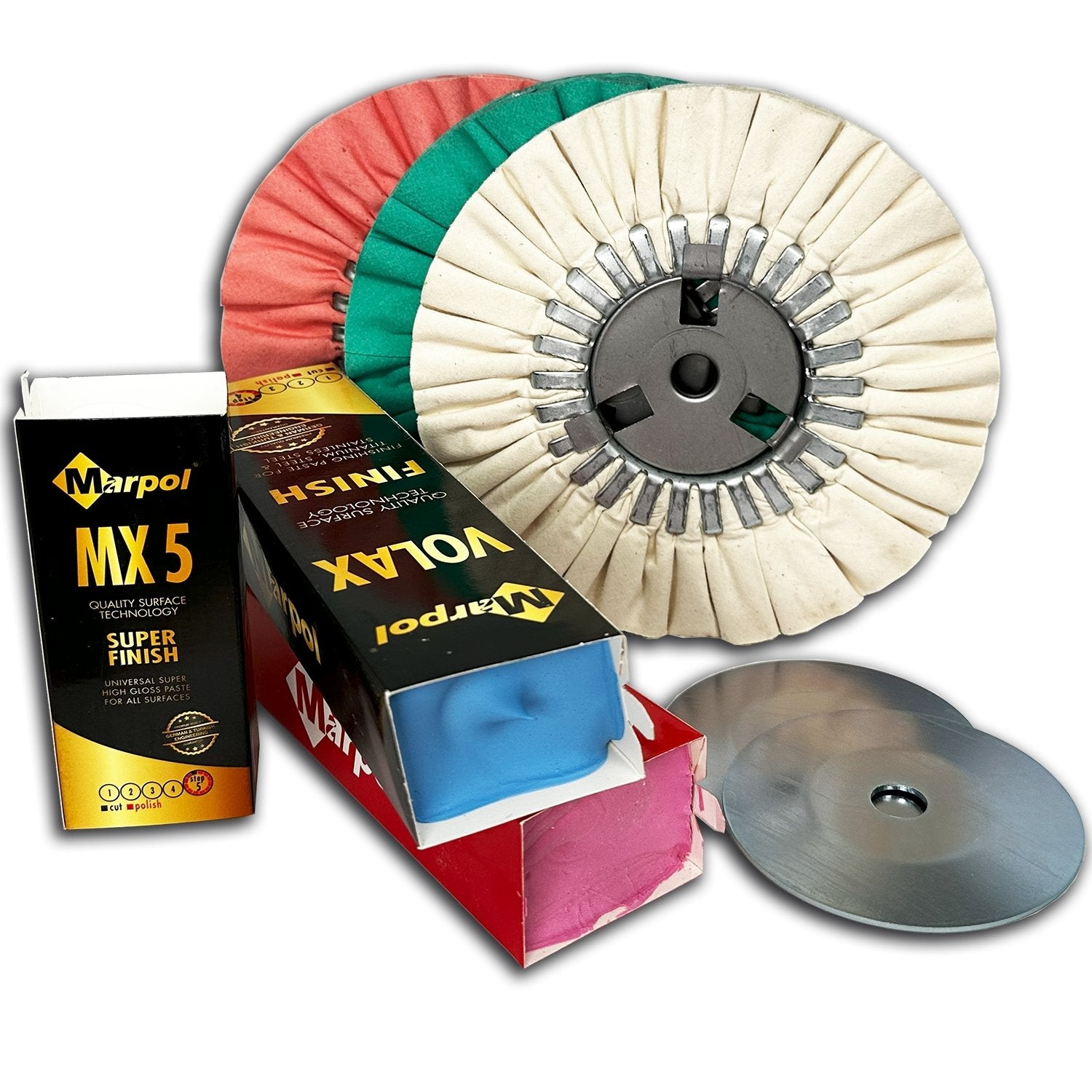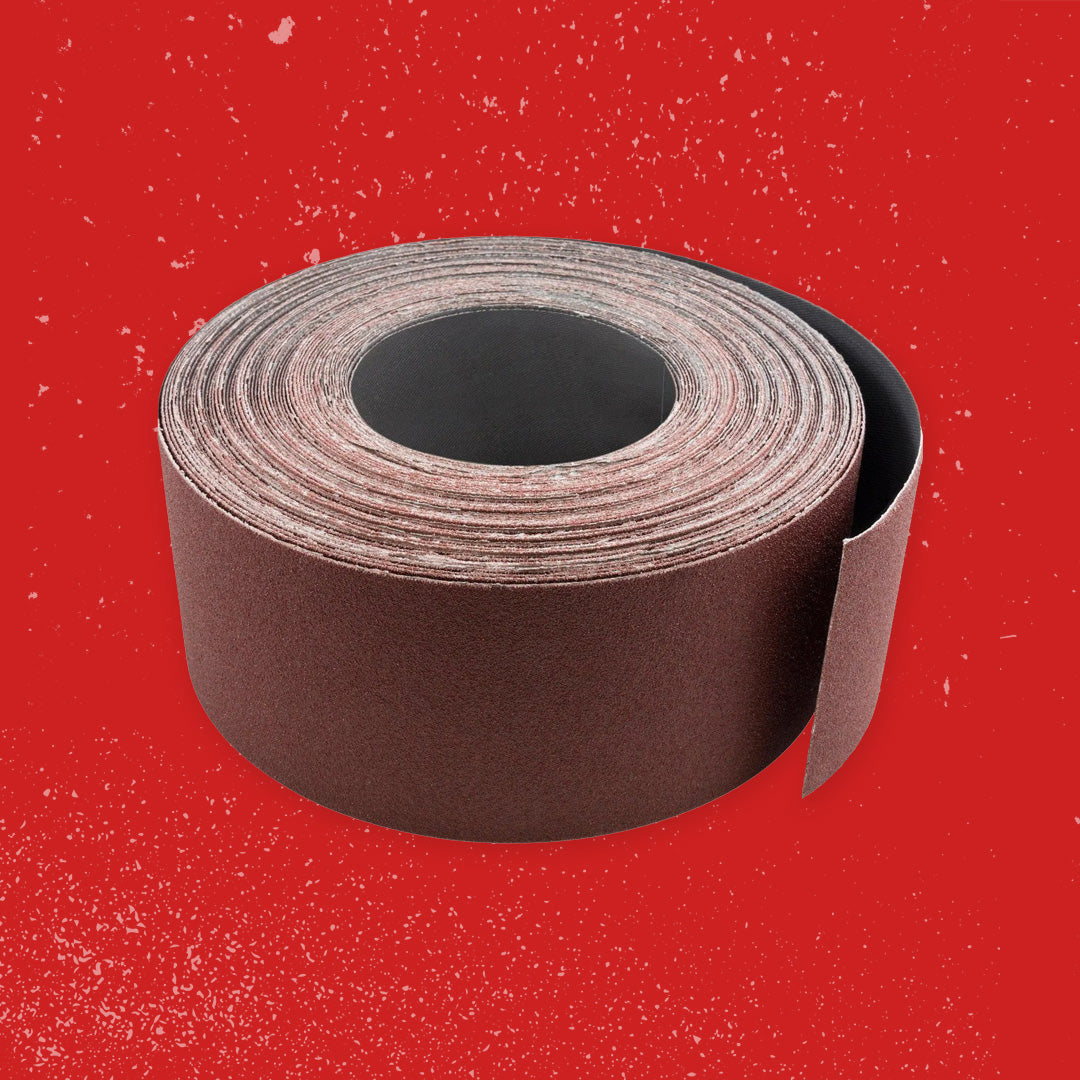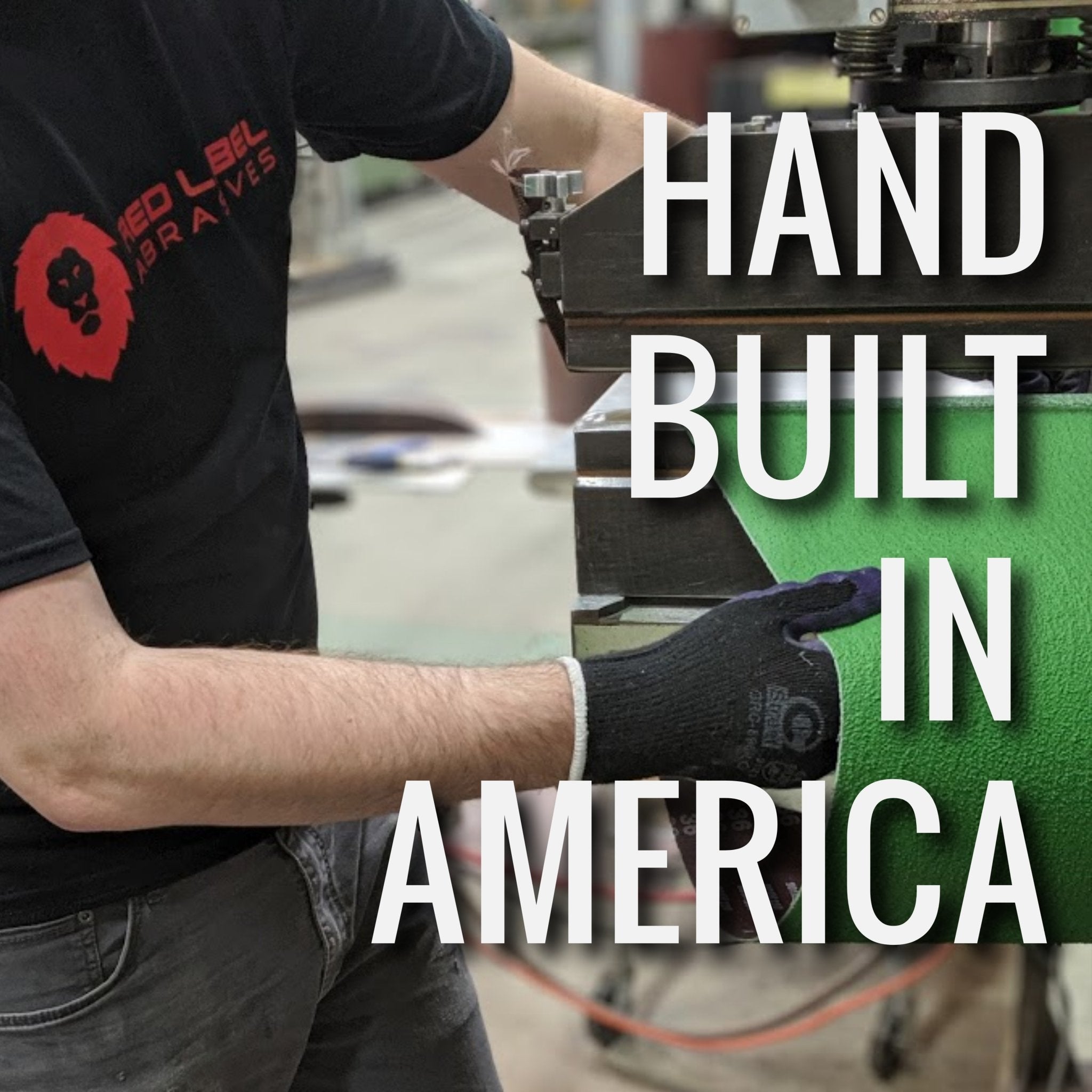Your Cart is Empty
Free Shipping over $150 (Excludes Oversized Products)
Free Shipping over $150 (Excludes Oversized Products)
Sanding Belts
Sanding Discs

Buffing Compounds: Types, Color Chart, and Applications
by David Kranker 8 min read

Quick Summary
Buffing compounds are solid abrasive products used with buffing wheels to remove defects, smooth surfaces, and create polished finishes. Each color corresponds to a grit level and purpose, such as black for heavy cutting, brown for medium cutting, white for fine polishing, and red for a high-gloss finish. Compounds are grouped into cutting, polishing, and finishing types, each suited for different stages of work. Choosing the right compound depends on the material, with softer options for plastics and fine compounds for jewelry and precious metals. Proper application involves cleaning the surface, using separate wheels for each compound, and following safety measures. Red Label Abrasives offers Premium Marpol Buffing Compounds matched to wheel types, providing a full range from ultra-heavy cut to super mirror finish.
Buffing compounds are solid polishing agents used to improve the surface quality of metals, plastics, and other materials. They help remove fine scratches, blend tool marks, and smooth out rough areas. When applied to a rotating buffing wheel, the compound acts like a fine abrasive that gradually refines the surface. Each compound is color-coded to reflect how aggressive or mild it is: while some are heavy cutting agents, others are fine finishing bars.
If you’ve worked with different materials before, you know that surfaces vary in condition and workability. Some need heavier abrasion to clean up imperfections, while others polish easily with a lighter touch. That’s why buffing compounds are produced in a range of colors, each intended for a certain task.
Knowing what each one does helps you avoid common mistakes, such as using a cutting compound during a final polish or mixing compounds on the same wheel. In this guide, you’ll see how these compounds work, how to match each color to the right material, and how to apply them for the best results.
What Are Buffing Compounds?
Buffing compounds are solid blocks made by combining abrasive grains with a wax or grease base. When applied to a rotating buffing wheel, the compound helps remove surface defects, smooth rough areas, and improve the appearance of a workpiece.
These compounds are used to prepare, refine, or finish surfaces made from metal, plastic, wood, or resin. Some remove scratches or oxidation left behind from sanding or grinding, while others help create a glossy or mirror-like finish. You’ll apply the compound by holding it against the spinning wheel, allowing the heat and friction to spread a thin, even layer onto the wheel surface.
Because the abrasive material is bonded into a solid stick, it’s easier to control how much product you apply. That gives you more consistency during polishing. Different compounds are paired with different types of buffing wheels depending on the surface and finish you’re trying to achieve. Using the wrong combination can waste time or leave swirl marks, so it’s important to match the right compound to the right task.
Buffing Compound Color Chart and What Each Color Means
Buffing compounds are often grouped by color, and each color is linked to how the compound performs. Some are used to cut through scratches or tool marks, while others are used to polish and bring out shine. While color is a helpful guide, it's always best to check the compound's grit level and intended use before applying it to a surface.
Here’s a breakdown of the most common buffing compound colors and how they’re used.
|
Color |
Use Type |
Common Materials |
Grit Level |
Finish Result |
|
Black |
Cutting |
Steel, stainless steel, iron |
Medium-Coarse |
Pre-polish |
|
Brown |
Cutting |
Brass, copper, aluminum |
Medium |
Smooth base |
|
White |
Polishing |
Aluminum, plastics, painted metal |
Fine |
Bright finish |
|
Green |
Final Polishing |
Stainless steel, chrome, platinum |
Very Fine |
High-gloss/mirror |
|
Red |
Final Polishing |
Gold, silver, brass |
Extra Fine |
Jewelers’ high-gloss |
|
Blue |
General Polishing |
Soft metals, plastics, wood |
Fine |
Bright luster |
|
Gray |
Cutting |
Steel, iron, hard metals |
Coarse |
Base surface prep |
|
Pink |
Light Polishing |
Acrylics, resins, thermoplastics |
Fine |
Clear smooth finish |
These colors can help you plan the right order of application. For example, you might use black or brown to cut and remove defects, then follow up with white or green for a polished shine.
While many manufacturers use similar color coding, it’s not a fixed standard. Red Label Abrasives uses colors consistent with industry norms, but you should always read the product description to make sure you’re using the right compound for your wheel and material.
Types of Buffing Compounds and Their Characteristics
Buffing compounds fall into three main categories: cutting, polishing, and finishing. When used in the right order, these compounds help you remove damage, smooth the surface, and create a better finish.
Cutting Compounds
Cutting compounds contain larger abrasive particles that remove surface defects like sanding lines, oxidation, or welding marks. They work best on rough metal and are usually applied during the first stage of surface preparation. Black, brown, and gray are common cutting compounds. They’re usually applied using harder buffing wheels such as treated cotton or sisal. This combination clears away unwanted texture or discoloration.
Polishing Compounds
Polishing compounds contain finer abrasives that clean up the surface after cutting is complete. They help reduce haze, blend marks, and improve shine. White and blue compounds, which are commonly used on materials like aluminum, brass, soft steel, and plastic, fall into this category. When paired with medium-density wheels like spiral-sewn cotton, they give you more control without digging into the surface.
Finishing Compounds
Made with very fine abrasives, finishing compounds create a high-gloss or mirror-like surface. Red, green, and pink are all finishing compounds commonly used on jewelry, chrome, or decorative parts. They remove minimal material but are ideal for increasing reflectivity in the final pass. You can use soft cotton or loose buffing wheels to help apply finishing compounds without scratching the surface.
Red Label Abrasives – Premium Marpol Buffing Compounds
Red Label offers a line of Premium Marpol Buffing Compounds that cover everything from heavy material removal to a mirror finish. Each compound is intended for use with a matching buffing wheel to achieve the best results.
- Black – C68 Carbo (Ultra Heavy Cut):This compound removes deep scratches and heavy oxidation on all metals. It works best with an orange treated cotton wheel for maximum cutting ability.
- Pink – C106 Heavy/Medium Cut:This option provides strong cutting power without being as aggressive as the black compound. It pairs well with a pink treated cotton wheel for balanced material removal.
- Blue – Volax Chrome (Mirror Finish):This compound is used to create a bright, reflective finish on metal surfaces. It performs well with a green treated cotton wheel for fine polishing.
- White – HighFin (Super Mirror Finish):This is the final step in achieving a true mirror finish on metal. Use it with a white untreated soft cotton wheel for the highest level of shine.
Choosing the Right Buffing Compound for Your Material
The right buffing compound depends on both the material and the finish you want to achieve. Each compound works best on certain surfaces and should be paired with an appropriate wheel to prevent damage and improve results.
Metals
For stainless steel, start with a black compound to cut away scratches or oxidation, then finish with green for a bright mirror polish. Aluminum responds well to brown for the cutting stage, followed by white or blue for polishing. Brass and copper benefit from Tripoli brown to smooth the surface, then red rouge for a rich, high-gloss finish.
Plastics and Acrylics
Plastics and acrylics require a gentle approach to prevent heat build-up and surface damage. Use blue or white compounds for polishing, paired with a soft cotton wheel. Avoid coarse cutting compounds, as they can leave scratches that are difficult to remove.
Wood
Buffing wood is typically reserved for resin-stabilized or turned pieces. Use fine polishing compounds like white or pink, which enhance the smoothness without removing too much material. Apply with a loose cotton wheel for an even finish.
Jewelry and Precious Metals
Gold, silver, and other precious metals benefit from extremely fine compounds. Red rouge is the traditional choice for these materials, as it produces a clean, reflective surface without causing scratches. For platinum, a green compound can help create a brilliant finish.
Buffing Compound Application Tips
Using buffing compounds correctly helps you get better results and avoid damaging your workpiece. Make sure that each stage builds on the last to create a cleaner finish.
Step-by-Step Usage Guide
- Start by cleaning the surface so no dust, grease, or debris interferes with polishing.
- Mount your buffing wheel securely, then bring it up to speed before applying compound.
- Hold the compound bar lightly against the spinning wheel so the heat and friction transfer a thin layer of material.
- Work the compound over the surface in steady passes, keeping the wheel moving to avoid heat build-up.
- Begin with a cutting compound to remove marks or oxidation, then switch to polishing or finishing compounds for finer work.
- Use a fresh wheel for each compound to prevent contamination between stages.
Safety and Maintenance Tips
- Wear safety glasses and gloves to protect against flying debris and accidental contact with the wheel.
- A dust mask is recommended when working with compounds that produce fine airborne particles.
- Always store compounds in a cool, dry place to maintain their texture and performance.
- Keep wheels clean between uses, and replace them when they show excessive wear or lose their shape.
How Do You Store Buffing Compounds To Extend Their Shelf Life?
Buffing compounds last longer when they’re stored in a cool, dry environment. Heat and humidity can soften the wax or grease binder, which reduces the compound’s effectiveness over time. Prolonged exposure to sunlight can also cause fading or drying, making it harder to apply evenly to the wheel.
To protect your compounds from dust and debris, keep them in sealed containers or plastic bags when they’re not in use. This also prevents contamination from other abrasives in your workspace. In addition:
- If you work with multiple compounds, label each one clearly so you can identify it at a glance.
- Avoid stacking heavy items on top of the bars, as this can cause them to break or deform.
With proper storage, your compounds will maintain their texture and performance, allowing you to achieve consistent results every time you polish.
Can You Mix Different Buffing Compounds On The Same Wheel?
Using more than one buffing compound on the same wheel can cause problems with your finish. Each compound contains a specific grit size and type of abrasive, and mixing them changes how the wheel cuts or polishes the surface. If coarse grit remains on the wheel when you add a fine finishing compound, the coarse particles can still scratch the material.
To avoid this issue, clean the wheel thoroughly before switching compounds. (A wheel rake is effective for removing old compound and restoring the wheel’s fibers.) But even with thorough cleaning, some makers prefer to dedicate a separate wheel to each compound. This approach eliminates the risk of contamination and ensures the wheel applies the compound as intended. By keeping compounds separate, you’ll maintain better control and improve the overall quality of your finish.
Why Is My Buffing Compound Not Sticking To The Wheel?
Buffing compound may not stick to the wheel if the wheel speed is too low or if the surface is dirty. A slow-spinning wheel doesn’t create enough friction to soften the compound and allow it to bond with the fibers, while contamination from dust, debris, or leftover compound can prevent proper adhesion.
Before applying a new compound, clean the wheel with a rake to remove any buildup. When you’re ready to apply it, press it lightly against the wheel so heat can develop and spread it evenly. (Too much pressure can cause the compound to crumble instead of coating the surface.) It’s also important to use the right type of wheel for the compound you’ve chosen. Matching the wheel’s density with the compound’s intended purpose creates better coverage and improves your results during polishing.
Stock Up On Buffing Equipment at Red Label Abrasives
Buffing compounds help you move from a rough surface to a polished, mirror-like finish in a controlled, repeatable manner. By choosing the right color and type for your material, you can remove imperfections, refine the surface, and create a finish that stands out. Using compounds in the proper order with the right wheels also makes your work cleaner and more efficient.
When you’re working with stainless steel, aluminum, plastic, wood, or jewelry, the right combination of cutting, polishing, and finishing compounds can make a clear difference. Red Label Abrasives offers buffing wheel kits, buffing belts, polishing stones, and buffing compounds for every stage of the process, giving you the tools to achieve professional results in your own shop. If you have questions or would like to place an order, please fill out a contact form or call 844-824-1956 today.
ABOUT THE AUTHOR
David Kranker is a writer and creative maker who has been covering the abrasive industry on the Red Label Abrasives Blog since 2020. David spends his time continually researching sanding techniques to provide readers with the latest and greatest information. In his free time, David utilizes abrasives for many different home and auto projects at his home in Delton, MI.
Our Most Popular Abrasives

EdgeCore Ceramic Sanding Belts

EdgeCore Ceramic Flap Discs

Buffing Kit
Shop By Product Category





Why Choose Red Label?







